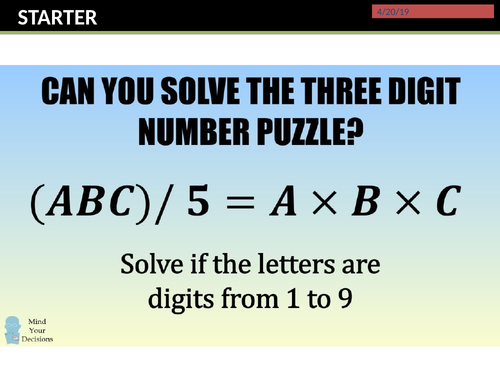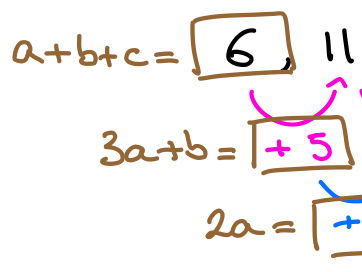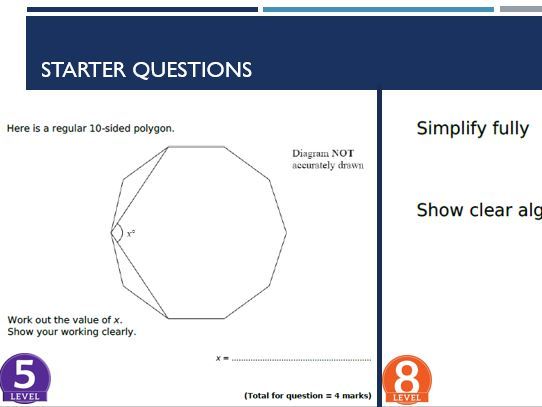
42Uploads
16k+Views
7k+Downloads
All resources

Angry Birds: Quadratics Project
Here is a great activity to do as a group, pairs or individually. I haven’t created it but wanted to share it with others. This activity looks at quadratics given in different forms; table of values, graphically, in words, and in standard form. The idea is to see which birds hit the pigs. There are 5 versions of this activity which is great. Students don’t need to know about vertex form (completing the square) for this activity, but do need to understand that the axis of symmetry is half way between the roots.

Time Series Assignment
Here is a short independent task looking at time series of population over time. It also creates discussion for curves of best fit.

IB Maths Analysis and Approaches SL: Quadratic Inequalities
I used this lesson before going into the quadratic formula and the discriminant.

GCSE 9-1 Maths Digit Proofs
For those higher achieving students looking to get a grade 9. As proofs is new to the Edexcel specification, digit proofs is not common but has shown up on a Mock Exam.

GCSE 9-1 Maths Must Know Topics
Lesson 1: Quadratic Sequences
Lesson 2: Completing the Square
Lesson 3: Iteration
Lesson 4: Composite Functions
Each lesson includes worked examples and practice questions. Alternative methods are shown for completing the square. Iteration lesson includes a video and graphical representation of how iteration works to deepen student understanding.

Bungee Barbie - Scatter Graphs and Line of Best Fit
This activity requires students to gather data to construct a scatter graph. After students have constructed the scatter graph they then have to find the equation of the line of best fit and use that to make a prediction of how many bands are needed for the bungee jump. Calculations will be off which lead to the discussion of interpolation and extrapolation and why maths in the real world does not always match up with theoretical predictions.
The PowerPoint comes with a worksheet that students will use to fill in. I have also attached an egg version. The activity will take at least 2 days. One day to gather their information and the second to test their predictions.

Quadratic Sequences - Complete Lesson
The lesson looks at the differences between a linear and quadratic sequences graphically and focusing on finite differences, thus leading to the nth term. The lesson identifies two methods for finding the nth term of a quadratic sequence with multiple questions in different contexts. Questions also have students transferring skills from other topics such as area, solving equations, simultaneous equations, etc.
This lesson can also be used with AQA Further Maths students as the PowerPoint ens with limiting value of a sequence.

Higher GCSE Maths Starters (Target 5 - 9)
Th bundle contains 32 days worth of starters. Each stater comprises of 2 questions. One being of level 4 or 5 and the other of level 7 to 9. The idea is that students will practice both questions from the beginning and ending of the exam. I find higher level students tend to make mistakes early of in the exam and this allows them to practice these types of questions in class. Thus helping to improve results.

Trigonometry - Tree Measuring
The following activity will allow students to use their knowledge on trigonometry along with applications on their phone and computer to estimate the height of the tree. The students will use 3 different methods to measure the height of a tree and at the end will comment on which method is the most accurate assuming the last method is the closest estimate.
Students really enjoyed going outside and applying their skills to this task. This activity is a great investigation for those looking to move in the the IB BP program.

GCSE 9-1 Maths Starters (Target Grades 4-6)
20 Maths starters for targeting grades 4 - 6 on a Higher Paper. Also works well if teaching a boarder line class with a few students writing the Foundation Exam. Most starters have complete solutions. Questions are taken from various Edexcel Exam papers and contains questions from levels 4 - 9. Certain higher level questions are given for students to transfer their skills and obtain some of the marks.

GCSE 9-1 Maths Higher Level Starters (Target 8-9)
The following starter questions are for students targeting grades 7-9. Questions are taken from various exam boards and include solutions. Encourages students to think and apply their skills in different contexts. Entire PowerPoint includes over 50 questions in the following categories:
Coordinate Geometry - Circles
Geometric Problems and Proof
Algebraic Proof
Trigonometry
Inequalities
Functions
Coordinate Geometry – Lines & Curves
Sequences
Algebraic Problems – including ratio
Indices and Surds
Statistics
Extra

IB Maths Applications and Interpretation SL: Chapter 13 - Integration
This unit contains 2 Powerpoints:
Integration
Trapezium Rule
Through the PowerPoint there are links to Youtube videos, GeoGebra and Desmos interactives. The PowerPoint has worked examples, and student exercises. I have also put in past paper exam questions for each topic.

Linear Functions - Straight Line Graph Quizzes
The following are 5 quizzes created for online teaching through Microsoft Teams. All 5 quizzes are multiple choice, so self marking. The 5 quizzes cover the entire topic of linear functions which are as follow:
Straight Line Graphs; graphing, finding an equation, finding gradient, interpreting equation, rearranging equations (25 questions)
Parallel and Perpendicular Lines (19 questions)
Modelling Linear Functions – Real Life Graphs (14 questions)
Distance and Midpoint (10 questions)
Equations of Perpendicular Bisectors (5 questions)

IB Maths Applications and Interpretation SL: Optimisation
The following lesson goes through the following:
-Optimisation without calculus
-The second derivative
-Optimisation with calculus
The lesson contains worked examples along with IB practice problems.

Embedded Linear Simultaneous Equations
30+ linear simultaneous equation problems. The PowerPoint starts with a quick recap on how to solve using either substitution or elimination. Most problems require students to transfer skills from other contexts in order to solve the problem. Problems include, linear and quadratic sequence, equations of quadratic graphs, angle properties, equation of a line, area and perimeter, index rules, HCF & LCM, pressure and density, etc.

IB Maths Applications and Interpretation SL: Chapter 12 - Differential Calculus
This unit contains 2 Powerpoints:
Differentiation
Optimisation
Through the PowerPoint there are links to Youtube videos, GeoGebra and Desmos interactives. The PowerPoint has worked examples, and student exercises. I have also put in past paper exam questions for each topic.
I have also included a worksheet with solutions.

IB Maths Applications and Interpretation SL: Jeopardy Revision Game
The following activity is a great way to spend last couple days revising.
The game has all the music and sounds like the real game.

IB Maths Analysis and Approaches SL: Rational Functions
The following contains PowerPoint goes through the following:
-the reciprocal function
-recap some transformations which has been learnt earlier
-horizontal and vertical asymptotes (vertical asymptotes have been mentioned earlier when students learnt domain and range)
-sketching rational functions looking at end behaviours
-finding horizontal asymptotes by taking the limit and by making x the subject (2 methods)
-solving algebraic fractions
-inverse functions
-application questions
The PowerPoints have worked examples, and student exercises. I have also put in past paper exam questions for each topic. There are also links to videos and inter-actives throughout.

IB Maths Analysis and Approaches SL: Jeopardy Revision Game
This game is intended for an EOY 12 Exam.
Units covered during the year were Number & Algebra, Functions, and Statistics and Probability. There is no probability questions in this game.
The game has all the music and sounds like the real game on TV. Students really enjoy it.

IB Maths Analysis and Approaches SL: Transformations
The following lesson goes through the following:
-translations
-enlargements (vertical and horizontal)
-reflections (both axis)
-parent functions
The PowerPoint has worked examples, and student exercises. I have also put in past paper exam questions for each topic. The idea of this lesson is for students to understand transformations and apply it to any function, hence why I talk about different parent functions (base curves).




















